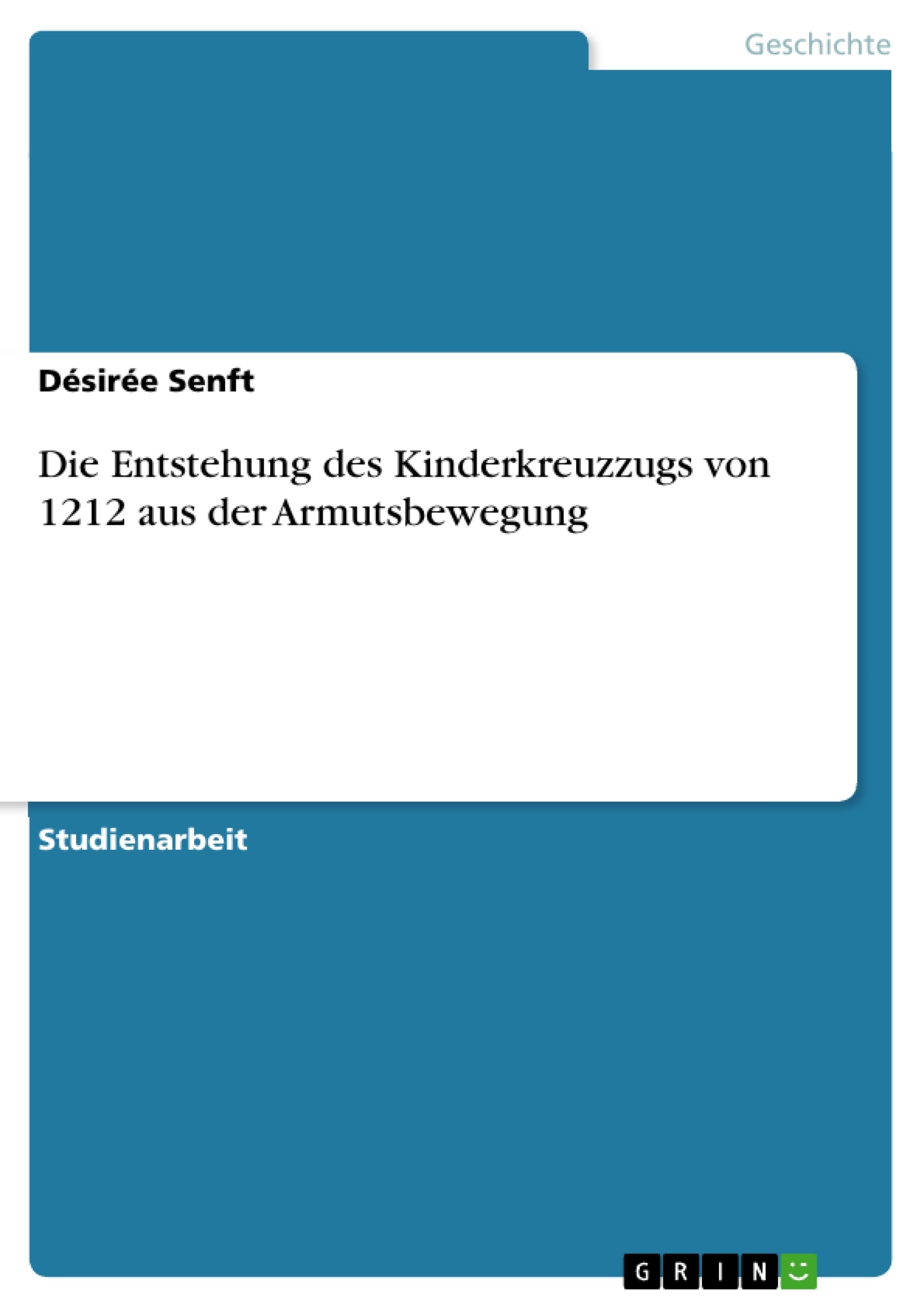Diese Arbeit besteht aus zwei Hauptthemen, namentlich dem Kinderkreuzzug von 1212 und der Armutsbewegung des Mittelalters unter Dominikanern und Franziskanern. Festgestellt werden soll, ob der Kinderkreuzzug als Folge der einsetzenden Armutsbewegung angesehen werden kann.
Inhaltsverzeichnis
- 1. Einleitung
- 2. Freiwillige Armut im Mittelalter
- 3. Die Bettelorden
- 3.1 Die Franziskaner
- 3.2 Die Dominikaner
- 3.3 Veränderung der Sichtweise der Armut durch die Lehre der Bettelorden
- 4. Entstehung des Kinderkreuzzugs von 1212
Zielsetzung und Themenschwerpunkte
Diese Arbeit untersucht die Entstehung des Kinderkreuzzugs von 1212 und den Einfluss der Armutsbewegung auf dieses Ereignis. Die Fragestellung zielt darauf ab, die Motive der jungen und armen Teilnehmer zu verstehen, die ihre Heimat verließen, um Jerusalem zurückzuerobern.
- Freiwillige und unfreiwillige Armut im Mittelalter
- Die Rolle der Bettelorden (Franziskaner und Dominikaner) in der Gesellschaft und im Kontext der Kreuzzüge
- Das Verständnis von Armut im 13. Jahrhundert
- Der Einfluss des Christozentrismus und der „imitatio Christi“ auf die Armutsbewegung
- Die Verbindung zwischen Armutsbewegung und dem Kinderkreuzzug von 1212
Zusammenfassung der Kapitel
1. Einleitung: Die Einleitung stellt den Kinderkreuzzug von 1212 als ein historisches Mysterium vor, dessen innere Organisation und das Schicksal seiner Teilnehmer weitgehend unbekannt sind. Sie skizziert die Forschungsfrage nach den Motiven der jungen und armen Kreuzfahrer und beschreibt den Aufbau der Arbeit. Die Arbeit stützt sich primär auf den Bericht von Matthäus Paris in seiner „Chronica Majora“.
2. Freiwillige Armut im Mittelalter: Dieses Kapitel differenziert zwischen freiwilliger und unfreiwilliger Armut im Mittelalter. Unfreiwillige Armut wird als Folge von Not, Krankheit oder Alter definiert, während freiwillige Armut auf dem Christozentrismus und der „imitatio Christi“ basiert, die ein Leben in Armut und Nächstenliebe propagierten. Das Kapitel zeigt auf, wie dieses Verständnis von Armut, insbesondere durch Wanderprediger, die Kreuzzugsbewegung beeinflusste und zur Mobilisierung von Massen für den Volkskreuzzug beitrug.
3. Die Bettelorden: Dieses Kapitel befasst sich mit der Entstehung und dem Einfluss der Bettelorden im 13. Jahrhundert. Es beschreibt die Franziskaner und Dominikaner als zentrale Akteure der Armutsbewegung, die durch ihr Leben in Armut und ihre missionarische Tätigkeit das Verständnis von Armut veränderten und den Kreuzzugsgedanken im Spätmittelalter weitertrugen. Die verschiedenen Aspekte der Armut (materiell und geistig) werden im Kontext der beiden Orden erläutert.
Schlüsselwörter
Kinderkreuzzug 1212, Armut im Mittelalter, Bettelorden, Franziskaner, Dominikaner, Christozentrismus, Imitatio Christi, Volkskreuzzug, Matthäus Paris, Chronica Majora.
Häufig gestellte Fragen zur Arbeit: Der Kinderkreuzzug von 1212
Was ist der Gegenstand dieser Arbeit?
Diese Arbeit untersucht den Kinderkreuzzug von 1212 und den Einfluss der mittelalterlichen Armutsbewegung auf dieses Ereignis. Im Mittelpunkt steht die Frage nach den Motiven der jungen und armen Teilnehmer, die ihre Heimat verließen, um Jerusalem zurückzuerobern.
Welche Themen werden behandelt?
Die Arbeit behandelt verschiedene Aspekte, darunter die Unterscheidung zwischen freiwilliger und unfreiwilliger Armut im Mittelalter, die Rolle der Bettelorden (Franziskaner und Dominikaner) im Kontext der Kreuzzüge, das Verständnis von Armut im 13. Jahrhundert, den Einfluss des Christozentrismus und der „imitatio Christi“, und die Verbindung zwischen Armutsbewegung und dem Kinderkreuzzug von 1212.
Welche Quellen werden verwendet?
Die Arbeit stützt sich primär auf den Bericht von Matthäus Paris in seiner „Chronica Majora“.
Wie ist die Arbeit aufgebaut?
Die Arbeit gliedert sich in eine Einleitung, Kapitel über freiwillige Armut im Mittelalter, die Bettelorden (Franziskaner und Dominikaner), und die Entstehung des Kinderkreuzzugs von 1212. Sie enthält ein Inhaltsverzeichnis, eine Zusammenfassung der Kapitel und Schlüsselwörter.
Welche Rolle spielten die Bettelorden?
Die Arbeit beschreibt die Franziskaner und Dominikaner als zentrale Akteure der Armutsbewegung. Ihre Lebensweise und missionarische Tätigkeit veränderten das Verständnis von Armut und trugen zum Kreuzzugsgedanken bei.
Wie wird Armut in der Arbeit definiert?
Die Arbeit unterscheidet zwischen freiwilliger Armut, basierend auf Christozentrismus und „imitatio Christi“, und unfreiwilliger Armut als Folge von Not, Krankheit oder Alter.
Welchen Einfluss hatte der Christozentrismus?
Der Christozentrismus und die „imitatio Christi“ spielten eine wichtige Rolle im Verständnis von freiwilliger Armut und beeinflussten die Armutsbewegung und damit indirekt den Kinderkreuzzug.
Welche Kapitel gibt es?
Die Arbeit umfasst folgende Kapitel: Einleitung, Freiwillige Armut im Mittelalter, Die Bettelorden (mit Unterkapiteln zu Franziskanern und Dominikanern und deren Einfluss auf das Verständnis von Armut), und die Entstehung des Kinderkreuzzugs von 1212.
Welche Schlüsselwörter sind relevant?
Schlüsselwörter sind: Kinderkreuzzug 1212, Armut im Mittelalter, Bettelorden, Franziskaner, Dominikaner, Christozentrismus, Imitatio Christi, Volkskreuzzug, Matthäus Paris, Chronica Majora.
- Quote paper
- Désirée Senft (Author), 2012, Die Entstehung des Kinderkreuzzugs von 1212 aus der Armutsbewegung, Munich, GRIN Verlag, https://www.grin.com/document/215949



